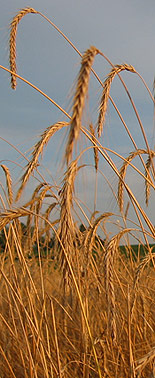
| Product
Lists & Information:
• Home • Place an Order • Snacks, Gifts, & Misc. • Favorite Recipes • Photos of our Farm • FAQ • Contact Us • Helpful Links Stay updated! Join our email list to receive occasional news about site updates, new products, sales, and more. We promise not to give your address to anyone else, and you're free to unsubscribe at any time. Get in touch: 2475 340th St. Laurel, IA 50141 (641) 476-3373 pauls@paulsgrains.com 
We hope you come back again! 
|
|
Bread Machines
We are often asked how to use whole grain flour and cereal in a bread machine. Because we do not have a bread machine ourselves, we asked a customer, Elaine Carr of Oregon, to share what she has learned in her many years of using a West Bend bread maker (unfortunately, these are no longer being built) and a Welbilt bread maker. Here's what Mrs. Carr had to say: We got a breadmaker in the first place because we both like homemade bread, and I was simply not home long enough at a good time to make it. I worked part time in our local library for some years, and a rushing schedule isn't compatible with the care one needs to give to bread making. We figure the machine has more than paid for itself in actual dollars and cents over buying ready-made bread. You get a little better bread product when using conventional pans in a conventional oven, but machine-made bread is quite acceptable. I have an Oster Kitchen Center with dough hooks with which I made many wonderful half-whole-wheat loaves in the past. But one needs to be around to be watchful and punch the dough down at the right time, so I haven't made bread conventionally for quite a while. I checked a Consumers Guide on breadmakers -- the book was a
year or so old. It did not recommend machine-made breads "in
less than an hour" as the quickly-raised bread is not a real
good quality. It mentioned that many manufacturers have
dropped out of the bread machine market. It said Salton is
owner of Breadman, Toastmaster and Welbilt, thus dominating
the market, and is also maker of Sears' and Walmart's Magic
Chef. They advised checking for counter space before buying,
as most machines are 12 or 13 inches tall, 10-11 inches deep,
and 10 to 19 inches wide. They said more of the bread pans now
are a more traditional shape. I see on the internet that West
Bend has come out with a 9 inch high machine which makes a 3/4
pound loaf (it is small!) baked in 45 minutes. Perhaps this
small loaf would be better quality than some.
Breadmakers vary. One of my machines requires a tablespoon or so less liquid for a satisfactory loaf. If you don't get a successful loaf the first time, remember that the "failure" can be used in bread-and-milk to make a good snack or satisfying supper. And don't forget old-fashioned bread pudding with its healthful eggs, milk, and delicious touch of cinnamon! When using grains which do not contain as much gluten as white flour contains, a tablespoon of gluten for each cup of flour and/or other grain may help. The gluten powder can be purchased at some grocery stores, and our health food store has it in bulk. I have small cups for my blender, which are good for grinding small amounts of rice, oatmeal, flax seed, etc. Some of Mrs. Carr's favorite bread machine recipes: Home | F.A.Q. | Recipes | Photos | Links | Contact | Order Whole Grains | Cereals | Flours | Snacks & Gifts Site design by ASourceOfJoy Graphic Design, © 2006 |